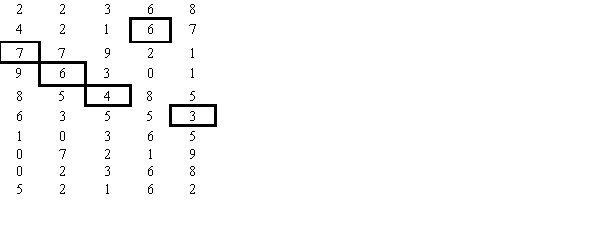Multiple Choice
Five students were scheduled to take a five-question true-false quiz on the history of the Peloponnesian War. Since they didn't know anything about the subject, they were faced with a decision of whether or not to study. Before they decided to study they decided to run a simulation to see how many of them would likely pass the quiz if they all just guessed randomly. At least three correct answers would be needed to pass. They made up a hypothetical set of correct answers as shown in the following table.  They then used the following random numbers table to ensure that the simulated responses would be truly random. Each simulated set of quiz responses began with a different highlighted number from the table and included the four numbers beneath it. An odd number was said to correspond to an answer of True, and an even number was said to correspond to an answer of False. How many passing grades were there in the five simulated responses?
They then used the following random numbers table to ensure that the simulated responses would be truly random. Each simulated set of quiz responses began with a different highlighted number from the table and included the four numbers beneath it. An odd number was said to correspond to an answer of True, and an even number was said to correspond to an answer of False. How many passing grades were there in the five simulated responses? 
A) 3
B) 4
C) 5
D) 6
Correct Answer:

Verified
Correct Answer:
Verified
Q3: _ sampling involves giving a questionnaire to
Q4: A pollster wanted to determine how much
Q5: A flip of a fair coin is
Q7: Identify the type of sample obtained by
Q10: Which of the following examples of a
Q11: Why would researchers want to use a
Q12: If all possible samples of a specific
Q13: Simulate ten coin tosses using the following
Q21: Simulation techniques go back to ancient times
Q27: An example of sampling could involve sampling